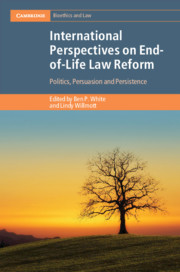Book contents
- International Perspectives on End-of-Life Law Reform
- Cambridge Bioethics and Law
- International Perspectives on End-of-Life Law Reform
- Copyright page
- Contents
- Preface
- About the Editors
- List of Contributors
- Table of Cases
- Table of Statutes, Bills and Regulations
- 1 End-of-Life Law Reform
- 2 The Path from Rodriguez to Bill C-14 and Beyond
- 3 The Extension of the Belgian Euthanasia Law to Minors in 2014
- 4 The Role of Scientific Evaluations of the Dutch Termination of Life on Request and Assisted Suicide (Review Procedure) Act
- 5 The Challenging Path to Voluntary Assisted Dying Law Reform in Australia
- 6 Should Assisted Dying Require the Consent of a High Court Judge?
- 7 Aid in Dying in the United States
- 8 The Medical Regulator as Law Reformer
- 9 Extrajudicial Resolution of Medical Futility Disputes
- 10 Challenging Mandatory Court Hearings for People in Vegetative and Minimally Conscious States
- 11 Withholding and Withdrawing Life-Prolonging Treatment and the Relevance of Patients’ Wishes
- 12 International Perspectives on Reforming End-of-Life Law
- Index
4 - The Role of Scientific Evaluations of the Dutch Termination of Life on Request and Assisted Suicide (Review Procedure) Act
Old Law, New Boundaries
Published online by Cambridge University Press: 02 December 2021
- International Perspectives on End-of-Life Law Reform
- Cambridge Bioethics and Law
- International Perspectives on End-of-Life Law Reform
- Copyright page
- Contents
- Preface
- About the Editors
- List of Contributors
- Table of Cases
- Table of Statutes, Bills and Regulations
- 1 End-of-Life Law Reform
- 2 The Path from Rodriguez to Bill C-14 and Beyond
- 3 The Extension of the Belgian Euthanasia Law to Minors in 2014
- 4 The Role of Scientific Evaluations of the Dutch Termination of Life on Request and Assisted Suicide (Review Procedure) Act
- 5 The Challenging Path to Voluntary Assisted Dying Law Reform in Australia
- 6 Should Assisted Dying Require the Consent of a High Court Judge?
- 7 Aid in Dying in the United States
- 8 The Medical Regulator as Law Reformer
- 9 Extrajudicial Resolution of Medical Futility Disputes
- 10 Challenging Mandatory Court Hearings for People in Vegetative and Minimally Conscious States
- 11 Withholding and Withdrawing Life-Prolonging Treatment and the Relevance of Patients’ Wishes
- 12 International Perspectives on Reforming End-of-Life Law
- Index
Summary
The Dutch Termination of Life on Request and Assisted Suicide (Review Procedure) Act (euthanasia law) came into force in 2002. The goals of the euthanasia law are to provide legal security for all involved in physician-assistance in dying, to assure prudent practice, and to provide a framework for physicians to be accountable and thus enable transparency and societal control. Every five years the law is evaluated to examine whether its objectives are (still) being met. In 2015–2017, this was done for the third time, by studying current practices, identifying new developments in the interpretation and conceptualisation of the legal criteria, which are formulated rather openly in the law, and analysing potential complexities of the review system. This chapter outlines the role of this evaluation in keeping the existing law under review. It is part of the ongoing examination of the operation, scope and effectiveness of the laws and so these findings contribute to deliberations about whether to change the law or not. The chapter also comments on the evaluation’s function in advising on suggested changes to the law.
Keywords
- Type
- Chapter
- Information
- International Perspectives on End-of-Life Law ReformPolitics, Persuasion and Persistence, pp. 63 - 83Publisher: Cambridge University PressPrint publication year: 2021



